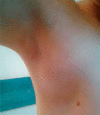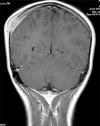Cat-scratch disease: a wide spectrum of clinical pictures
- PMID: 26161064
- PMCID: PMC4495109
- DOI: 10.5114/pdia.2014.44014
Cat-scratch disease: a wide spectrum of clinical pictures
Abstract
The aim of this review is to present an emerging zoonotic disease caused by Bartonella henselae. The wide spectrum of diseases connected with these bacteria varies from asymptomatic cases, to skin inflammation, fever of unknown origin, lymphadenopathy, eye disorders, encephalitis and endocarditis. The reservoirs of B. henselae are domestic animals like cats, guinea pigs, rabbits and occasionally dogs. Diagnosis is most often based on a history of exposure to cats and a serologic test with high titres of the immunoglobulin G antibody to B. henselae. Most cases of cat-scratch disease are self-limited and do not require antibiotic treatment. If an antibiotic is chosen, however, azithromycin has been shown to speed recovery.
Keywords: Bartonella henselae; cat scratch disease; child; lymphadenopathy.
Figures





References
-
- Mazur-Melewska K, Macedulski T, Prusinowska J, et al. Variable, clinical course of the cat scratch disease. Pediat Med Rodz. 2012;8:176–9.
-
- Podsiadły E, Sokołowska E, Tylewska-Wierzbanowska S. Seroprevalence of Bartonella henselae and Bartonella quintana infections in Poland in 1998-2001. Przegl Epidemiol. 2002;56:399–407. - PubMed
-
- Boulouis HJ, Chang CH, Henn JB, et al. Factor associated with the rapid emergence of zoonotic Bartonella infections. Vet Res. 2005;36:383–410. - PubMed
Publication types
LinkOut - more resources
Full Text Sources
Other Literature Sources
Miscellaneous
